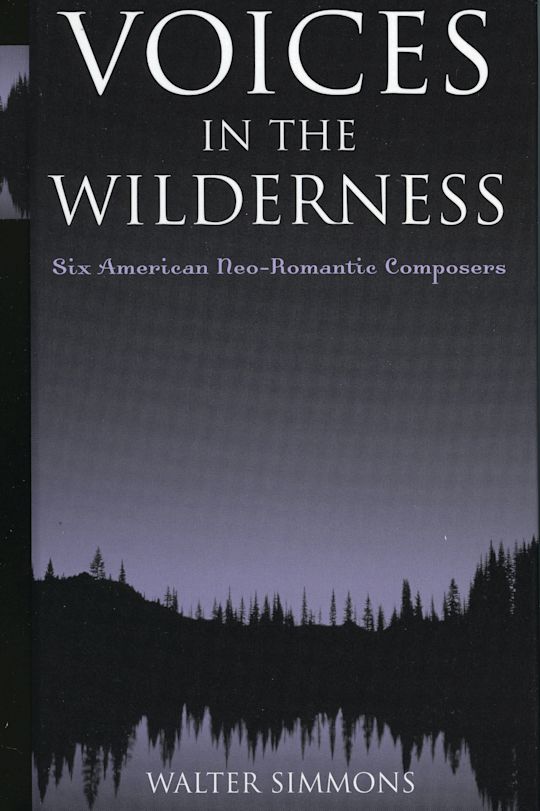- Home
- ACADEMIC
- Music & Sound Studies
- Classical Music
- Voices in the Wilderness
This product is usually dispatched within 10-14 days
- Delivery and returns info
-
Free UK delivery on orders £30 or over
You must sign in to add this item to your wishlist. Please sign in or create an account
Description
Despite the Modernist search for new and innovative aesthetics and rejection of traditional tonality, several twentieth century composers have found their own voice while steadfastly relying on the aesthetics and techniques of Romanticism and 19th century composition principles. Musicological and reference texts have regarded these composers as isolated exceptions to modern thoughts of composition_exceptions of little importance, treated simplistically and superficially. Music critic and scholar Walter Simmons, however, believes these composers and their works should be taken seriously. They are worthy of more scholarly consideration, and deserve proper analysis, assessment, and discussion in their own regard. In Voices in the Wilderness, the first in a series of books celebrating the 'Twentieth-Century Traditionalist,' Simmons looks at six Neo-Romantic composers: Ernest Bloch Howard Hanson Vittorio Giannini Paul Creston Samuel Barber Nicolas Flagello Through biographical overviews and a comprehensive assessment of musical works, Simmons provides readers with a clear understanding of the significance of the composers, their bodies of work, and their placement in musicological history. The chapters delve deeply and objectively into each composer's oeuvre, addressing their origins, stylistic traits and consistencies, phases of development, strengths and weaknesses, and affinities with other composers. The composers' most representative works are identified, and each chapter concludes with a discography of essential recordings. Visit the author's website to read samples from the book and to listen to representative excerpts of each composer's work.
Table of Contents
Part 2 1. Introduction
Chapter 3 The American Neo-Romantics
Chapter 4 Organization and Use of This Book
Chapter 5 Notes
Chapter 6 Selected Bibliography
Part 7 2. Ernest Bloch
Chapter 8 Biography
Chapter 9 Music
Chapter 10 Most Representative, Fully Realized Works
Chapter 11 Early Works: First European Period (1901-1906)
Chapter 12 Maturity: First European Period (1909-1916)
Chapter 13 Maturity: New York Period (1916-1919)
Chapter 14 Maturity: Cleveland Period (1920-1925)
Chapter 15 Maturity: San Francisco Period (1925-1929)
Chapter 16 Maturity: Second European Period (1930-1939)
Chapter 17 Later Maturity: Oregon Period (1939-1959)
Chapter 18 Conclusion
Chapter 19 Notes
Part 20 3. Howard Hanson
Chapter 21 Biography
Chapter 22 Music
Chapter 23 Most Representative, Fully Realized Works
Chapter 24 Early Period (until 1920)
Chapter 25 Early Maturity (1921-1946)
Chapter 26 Later Maturity (after 1947)
Chapter 27 Conclusion
Chapter 28 Notes
Chapter 29 Selected Bibliography
Chapter 30 Essential Discography
Part 31 4. Vittorio Giannini
Chapter 32 Biography
Chapter 33 Music
Chapter 34 Most Representative, Fully Realized Works
Chapter 35 First Phase (1920s through Early 1940s)
Chapter 36 Second Phase (Early 1940s through 1960s)
Chapter 37 Third Phase (1960-1966)
Chapter 38 Conclusion
Chapter 39 Notes
Chapter 40 Selected Bibliography
Chapter 41 Essential Discography
Part 42 5. Paul Creston
Chapter 43 Biography
Chapter 44 Music
Chapter 45 Stylistic Features
Chapter 46 Most Representative, Fully Realized Works
Chapter 47 Discussion of Works
Chapter 48 Conclusion
Chapter 49 Notes
Chapter 50 Selected Bibliography
Chapter 51 Essential Discography
Part 52 6. Samuel Barber
Chapter 53 Biography
Chapter 54 Music
Chapter 55 Most Representative, Fully Realized Works
Chapter 56 "Childhood": Early Period (until 1942)
Chapter 57 "Adolescence": Period of Exploration and Experimentation (1942 through 1952)
Chapter 58 "Adulthood": Music of Maturity (after 1952)
Chapter 59 Conclusion
Chapter 60 Notes
Chapter 61 Selected Bibliography
Chapter 62 Essential Discography
Part 63 7. Nicolas Flagello
Chapter 64 Biography
Chapter 65 Music
Chapter 66 Most Representative, Fully Realized Works
Chapter 67 Early Period (until 1958)
Chapter 68 Transitional Period (1958-1959)
Chapter 69 Mature Period (1959-1985)
Chapter 70 Conclusion
Chapter 71 Notes
Chapter 72 Selected Bibliography
Chapter 73 Essential Discography
Part 74 Index
Part 75 About the Author
Product details
| Published | 24 Feb 2006 |
|---|---|
| Format | Paperback |
| Edition | 1st |
| Extent | 432 |
| ISBN | 9780810857285 |
| Imprint | Scarecrow Press |
| Dimensions | 211 x 183 mm |
| Series | Modern Traditionalist Classical Music |
| Publisher | Bloomsbury Publishing |
About the contributors
Reviews
-
Recommended. Upper-division undergraduates through faculty; professionals; general readers.
Choice Reviews
-
Numerous quotations as well as notes and bibliography reflect the author's painstaking research. Of special interest to record collectors, there's a discography of essential recordings for each composer...a special pleasure of Voices in the Wilderness is the remarkable precision and clear-sightedness of Simmons's analyses of his six composers' strengths and weaknesses. In sum, this is a scrupulous, detailed, thoughtful, enlightening, and much-needed book on an important group of modern American composers who've been until now much too easily dismissed as reactionaries and throwbacks. We're fortunate that someone with a lifetime of devotion to their music has written it...
American Record Guide
-
The book's virtues shine. Simmons writes clearly and even eloquently…providing both an introduction for the novice and a deeper instruction for someone already acquainted with the music.
Steve Schwartz, Classical Net
-
I can only cheer as Simmons delivers knockout punches to the serialist academics who ruled the world and American music scenes in the 1960s and 1970s...the author delivers some brilliant flashes of insight...This alternate version of a period of history of American music could hardly be better represented than by Voices in the Wilderness.
Fanfare Magazine
-
Simmons' book should be a set text for students of music history everywhere. The marginalisation of some musicians, the primacy of fashion and the brutal interface between economics and arts make for provocative reading . . . Slake your enthusiastic curiosity with this well informed and poised book but be prepared to discover new enthusiasms and the nagging grains of fresh curiosity . . . do not be surprised if you come away with questions seriously disturbing to the concert and recording status quo.
Rob Barnett, MusicWeb International
-
As a work of music criticism, Voices is as close to a model of its kind as anything I have ever read....Simmons's introduction, in which he lays out the case for reconsidering these composers and the reasons for their neglect, is worth the price of the book by itself....I am in admiration of what he has achieved here. I am also immensely grateful for the in-depth treatment afforded to each of these six composers...The very hardest thing for a music critic to do is to put in words the 'meaning' of a piece of music. Simmons is particularly gifted in doing this, and it is what makes Voices so valuable.
Robert Reilly, American Foreign Policy Council, Crisis





























